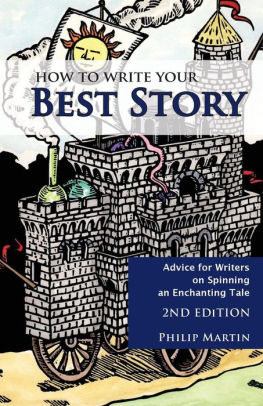
Writing
Your Best Story: Advice for Writers on Spinning an Enchanting Tale, Second
Edition
By Philip Martin
Crickhollow Books
Copyright, November 15, 2017
168 pp.
Ebook $2.99
Print $14.95
Buy on Barnes and Noble
Buy on Amazon
About the book:
“I find that most people know what a
story is until they sit down to write one.” – Flannery O’Connor.
Beginning writers often wonder what
it takes to get published. The second edition of this practical book looks at
what really makes fiction work: good storytelling! Oddly, storytelling skills,
despite their immense value to all writers, are seldom emphasized in writing
courses.
How To Write Your Best Story
explores three key elements that fuel the magic of story: intriguing
eccentricity, delightful details, and satisfying surprises. The proven
storytelling techniques are time-tested and used by the best authors, including
by winners of the Nobel Prize, the Pulitzer, and National Book Award, as well
as by commercially successful authors whose books appear on bestseller lists
and whose work is treasured by generations of fans.
Written by an accomplished editor
and indie-press publisher, this guide draws on the author’s decades of
experience in the book trade, studying what really works for emerging writers
and editing many books of advice on literary craft and career development.
The practical tips, techniques, and
examples of best practices here draw on the work of great literary storytellers
– from Shakespeare, Dickens, Robert Louis Stevenson, and Mark Twain to Willa
Cather, E.B. White, and James Thurber to Neil Gaiman, Ivan Doig, and Patrick
Rothfuss.
How To Write Your Best Story will
help you understand how to craft better fiction (or nonfiction) and to get your
best work published.
Lisa's review:
Framed in a story of the author’s creation, Philip Martin
sets off to do what all good mentors teach—show, not tell—in this case,
authors, how to create a good story that enchants.
Story should rise above narrative, Martin writes; more than
groups of words, more than a series of events. It is also an art form. Quoting
liberally from ancient to modern works, Martin employs his background as a
professional gatherer of stories and histories to show how story works across
culture and time to draw listeners in to a communal experience. Writers are
more than purveyors of phrases. Writers offer a promise and provide the
worthwhile payoff.
As an experienced editor of writer’s advice books, a former
editor for best-selling mainstream authors, and the director of Great Lakes
Literary, Martin shares his advice and technique for creating memorable works
that hopefully attract an agent or editor. He takes a three-pronged approach,
and so this book is divided into sections: start with a quirky hook; keep the
middle more than readable by using delicious details, and finally, provide a
satisfying ending.
Martin is not a fan of Plot. Plot, as a mechanism for
writing a book, will make your work…mechanical. Contrived. Agenda-driven.
Unimaginative. I believe his emphatic dissing of the term throughout the book
is more a rebellion of the idea of plot, an issue of interpretation. After all,
experienced authors are familiar with the idea of a novel being “plot-driven,”
as in genre work, or “character-driven,” as more often describes non-specified
fiction, aka literary work. No real matter, as Martin does make allowance for
necessary underpinning of a story, whether compared to a sensual meal or a
spider web. Plot is simply structure, whether an author uses it for a flexible
framework, or discovers it after the story is complete. Structure works to
create a commonly understood or shared experience. Too many authors use plot as
a controlled formula, which Martin insists must be avoided.
Whether cyclic or arced or linear, a story has a beginning,
middle, and an end. It’s the promise of a fine meal promised and fulfilled.
Start with a desire or a want. Bait your hook with enticing morsels. Help the
reader invest, establish resonating characters in intriguing environments. Give
them a problem to work on. Create anticipation; offer satisfying surprises.
“Delightful details” keep the reader’s interest and should build upon the
premise. “Detail should triumph plot,” Martin says. Even while he dismisses
Plot, Martin embraces Theme. “Theme should tell you what the ending should deal
with,” he writes. Don’t try to find it until you’re well into your story. Theme
is a message that answers why the story is important. The end of your tale
should let the reader know this journey has been worthwhile, that he has
returned better for having taken it with you, the story teller.
The book is well written with an easy-to-appreciate style.
As mentioned above, he spins a story to show us how to create interesting
characters with interesting problems who need interesting solutions to achieve
desired outcomes. Martin also shares examples from well-known work to exemplify
his points. While geared specifically with writers in mind, those who practice
verbal story-telling would certainly benefit from reading and studying Writing
Your Best Story. The premises and examples Martin lays out in the book apply to
all kinds of writing from short story to full length novel, even on a certain
level to non-fiction.
About
the author
No comments:
Post a Comment